Business Finance Report: Financial Performance Analysis, Module 1
VerifiedAdded on 2022/12/27
|13
|3403
|96
Report
AI Summary
This report provides a detailed analysis of business finance, focusing on cash flow, profit, and working capital management. Task 1 examines the relationship between profit and cash flow, the impact of working capital changes, and the influence of company management on financial results. It offers recommendations for improving cash flow, such as reducing debt and optimizing working capital. Task 2 presents a monthly cash budget for Thorne Estate over four months, offering insights into cash needs and allocation. The report concludes with recommendations to enhance cash flow, including making realistic projections, managing receipts effectively, and consolidating predictable expenses. The analysis provides valuable insights for financial decision-making and business sustainability.
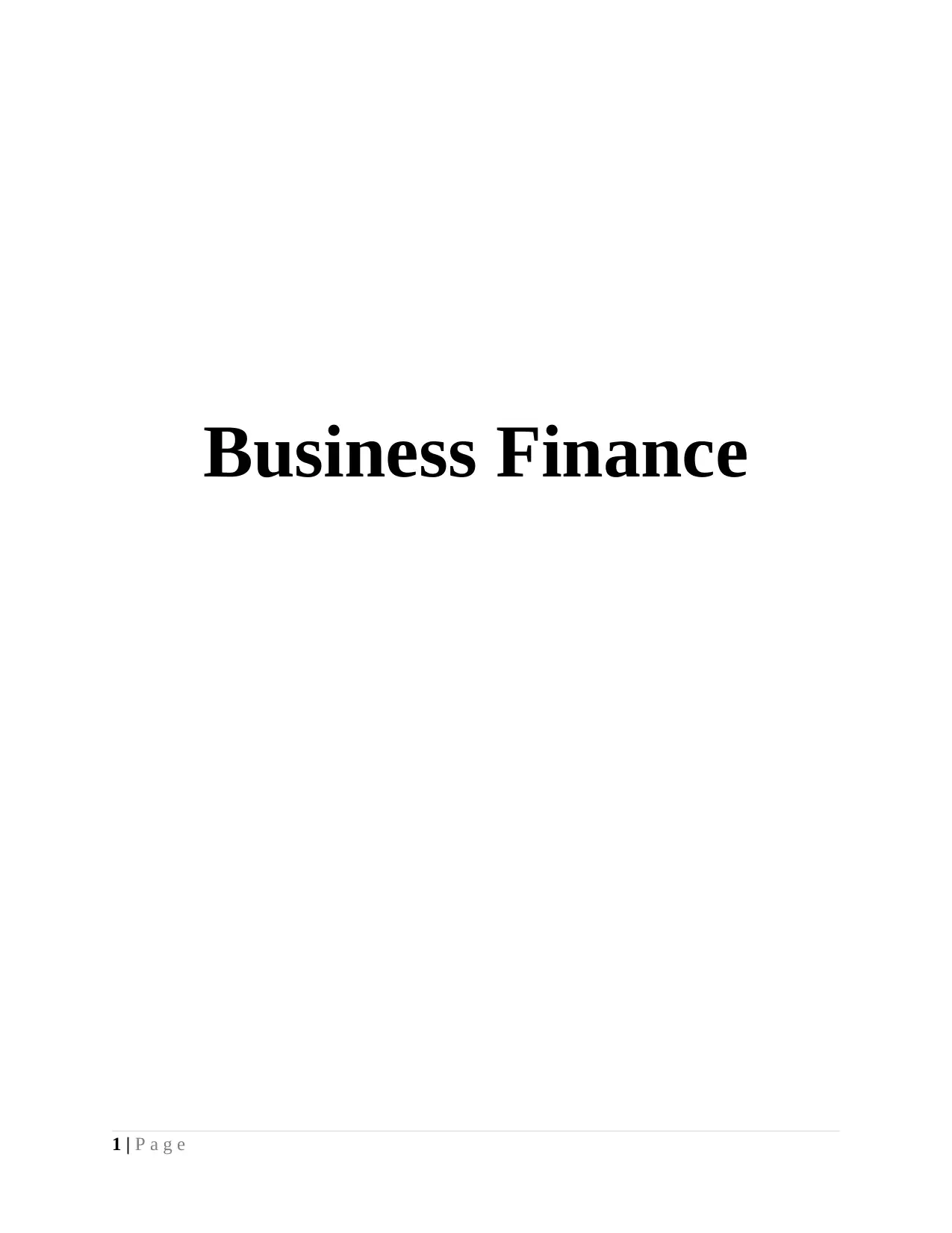
Business Finance
1 | P a g e
1 | P a g e
Paraphrase This Document
Need a fresh take? Get an instant paraphrase of this document with our AI Paraphraser
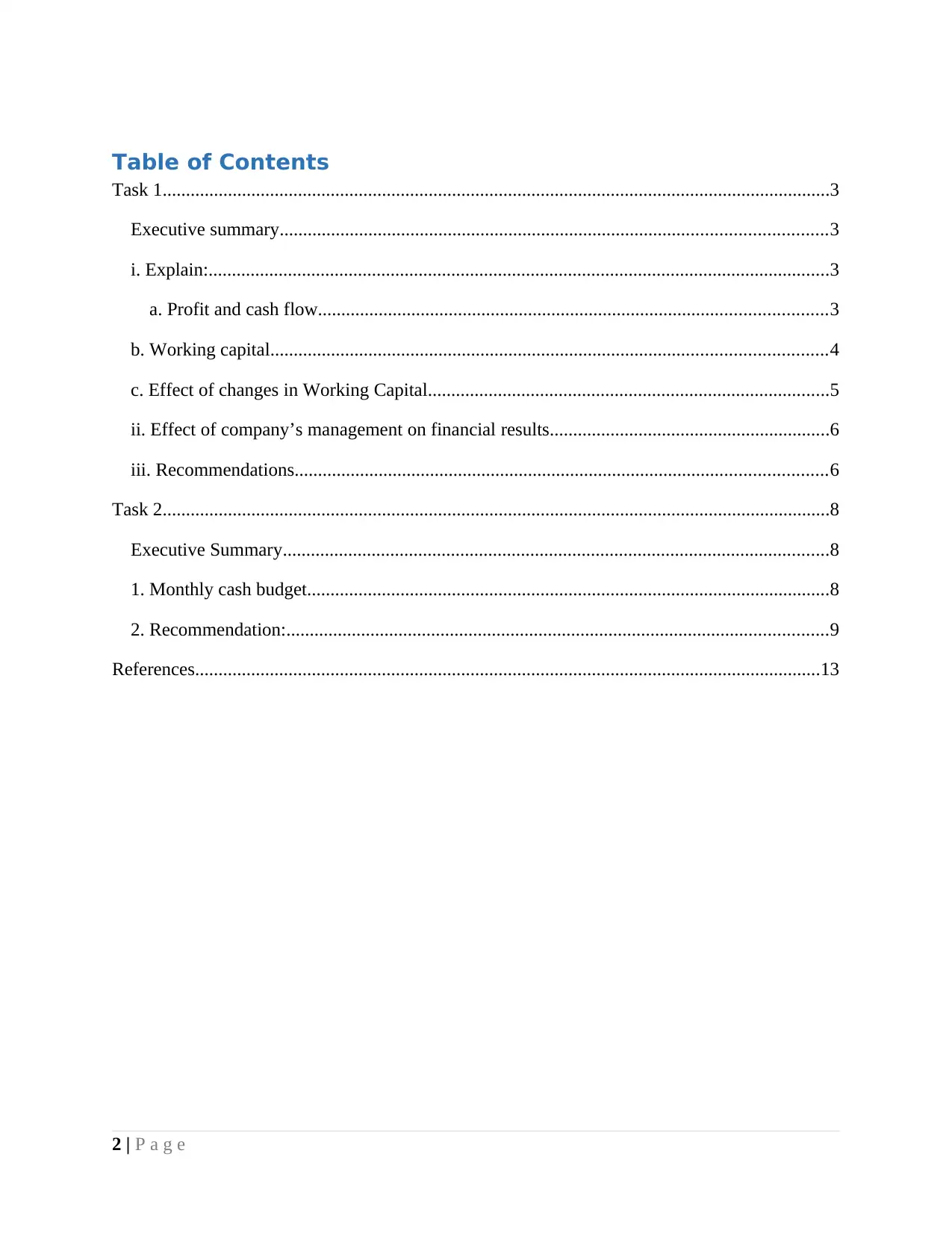
Table of Contents
Task 1...............................................................................................................................................3
Executive summary.....................................................................................................................3
i. Explain:.....................................................................................................................................3
a. Profit and cash flow.............................................................................................................3
b. Working capital.......................................................................................................................4
c. Effect of changes in Working Capital......................................................................................5
ii. Effect of company’s management on financial results............................................................6
iii. Recommendations..................................................................................................................6
Task 2...............................................................................................................................................8
Executive Summary.....................................................................................................................8
1. Monthly cash budget................................................................................................................8
2. Recommendation:....................................................................................................................9
References......................................................................................................................................13
2 | P a g e
Task 1...............................................................................................................................................3
Executive summary.....................................................................................................................3
i. Explain:.....................................................................................................................................3
a. Profit and cash flow.............................................................................................................3
b. Working capital.......................................................................................................................4
c. Effect of changes in Working Capital......................................................................................5
ii. Effect of company’s management on financial results............................................................6
iii. Recommendations..................................................................................................................6
Task 2...............................................................................................................................................8
Executive Summary.....................................................................................................................8
1. Monthly cash budget................................................................................................................8
2. Recommendation:....................................................................................................................9
References......................................................................................................................................13
2 | P a g e
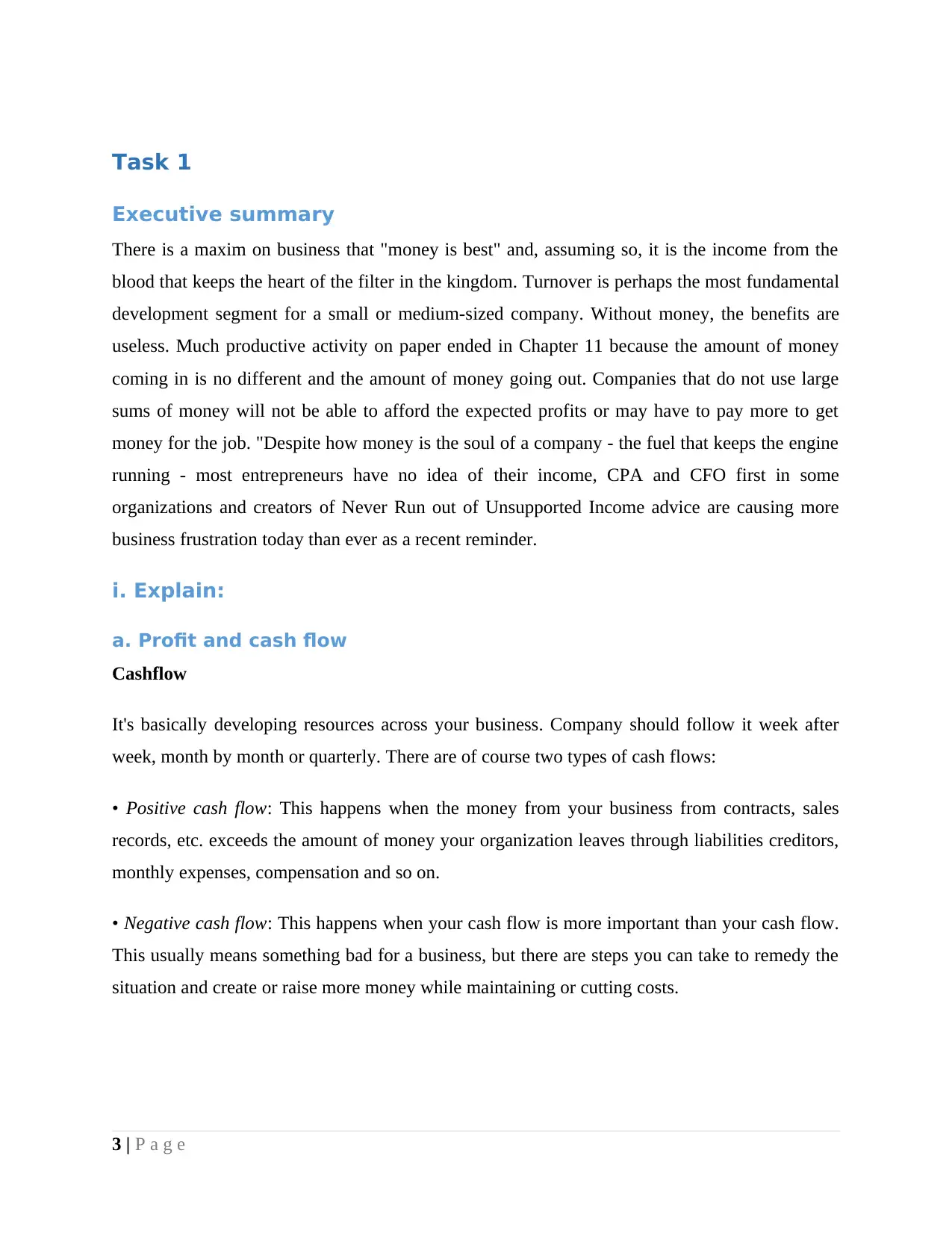
Task 1
Executive summary
There is a maxim on business that "money is best" and, assuming so, it is the income from the
blood that keeps the heart of the filter in the kingdom. Turnover is perhaps the most fundamental
development segment for a small or medium-sized company. Without money, the benefits are
useless. Much productive activity on paper ended in Chapter 11 because the amount of money
coming in is no different and the amount of money going out. Companies that do not use large
sums of money will not be able to afford the expected profits or may have to pay more to get
money for the job. "Despite how money is the soul of a company - the fuel that keeps the engine
running - most entrepreneurs have no idea of their income, CPA and CFO first in some
organizations and creators of Never Run out of Unsupported Income advice are causing more
business frustration today than ever as a recent reminder.
i. Explain:
a. Profit and cash flow
Cashflow
It's basically developing resources across your business. Company should follow it week after
week, month by month or quarterly. There are of course two types of cash flows:
• Positive cash flow: This happens when the money from your business from contracts, sales
records, etc. exceeds the amount of money your organization leaves through liabilities creditors,
monthly expenses, compensation and so on.
• Negative cash flow: This happens when your cash flow is more important than your cash flow.
This usually means something bad for a business, but there are steps you can take to remedy the
situation and create or raise more money while maintaining or cutting costs.
3 | P a g e
Executive summary
There is a maxim on business that "money is best" and, assuming so, it is the income from the
blood that keeps the heart of the filter in the kingdom. Turnover is perhaps the most fundamental
development segment for a small or medium-sized company. Without money, the benefits are
useless. Much productive activity on paper ended in Chapter 11 because the amount of money
coming in is no different and the amount of money going out. Companies that do not use large
sums of money will not be able to afford the expected profits or may have to pay more to get
money for the job. "Despite how money is the soul of a company - the fuel that keeps the engine
running - most entrepreneurs have no idea of their income, CPA and CFO first in some
organizations and creators of Never Run out of Unsupported Income advice are causing more
business frustration today than ever as a recent reminder.
i. Explain:
a. Profit and cash flow
Cashflow
It's basically developing resources across your business. Company should follow it week after
week, month by month or quarterly. There are of course two types of cash flows:
• Positive cash flow: This happens when the money from your business from contracts, sales
records, etc. exceeds the amount of money your organization leaves through liabilities creditors,
monthly expenses, compensation and so on.
• Negative cash flow: This happens when your cash flow is more important than your cash flow.
This usually means something bad for a business, but there are steps you can take to remedy the
situation and create or raise more money while maintaining or cutting costs.
3 | P a g e
⊘ This is a preview!⊘
Do you want full access?
Subscribe today to unlock all pages.

Trusted by 1+ million students worldwide
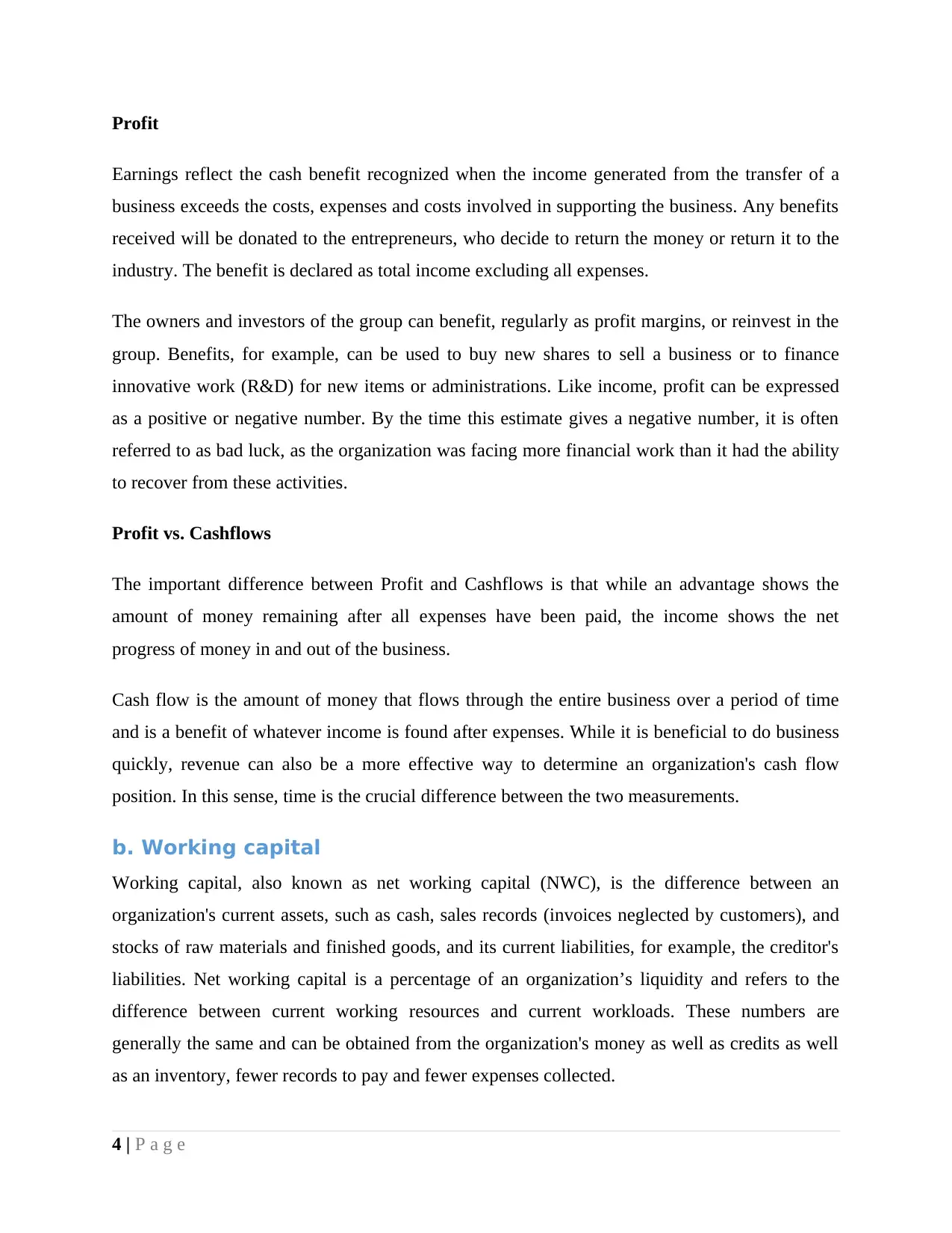
Profit
Earnings reflect the cash benefit recognized when the income generated from the transfer of a
business exceeds the costs, expenses and costs involved in supporting the business. Any benefits
received will be donated to the entrepreneurs, who decide to return the money or return it to the
industry. The benefit is declared as total income excluding all expenses.
The owners and investors of the group can benefit, regularly as profit margins, or reinvest in the
group. Benefits, for example, can be used to buy new shares to sell a business or to finance
innovative work (R&D) for new items or administrations. Like income, profit can be expressed
as a positive or negative number. By the time this estimate gives a negative number, it is often
referred to as bad luck, as the organization was facing more financial work than it had the ability
to recover from these activities.
Profit vs. Cashflows
The important difference between Profit and Cashflows is that while an advantage shows the
amount of money remaining after all expenses have been paid, the income shows the net
progress of money in and out of the business.
Cash flow is the amount of money that flows through the entire business over a period of time
and is a benefit of whatever income is found after expenses. While it is beneficial to do business
quickly, revenue can also be a more effective way to determine an organization's cash flow
position. In this sense, time is the crucial difference between the two measurements.
b. Working capital
Working capital, also known as net working capital (NWC), is the difference between an
organization's current assets, such as cash, sales records (invoices neglected by customers), and
stocks of raw materials and finished goods, and its current liabilities, for example, the creditor's
liabilities. Net working capital is a percentage of an organization’s liquidity and refers to the
difference between current working resources and current workloads. These numbers are
generally the same and can be obtained from the organization's money as well as credits as well
as an inventory, fewer records to pay and fewer expenses collected.
4 | P a g e
Earnings reflect the cash benefit recognized when the income generated from the transfer of a
business exceeds the costs, expenses and costs involved in supporting the business. Any benefits
received will be donated to the entrepreneurs, who decide to return the money or return it to the
industry. The benefit is declared as total income excluding all expenses.
The owners and investors of the group can benefit, regularly as profit margins, or reinvest in the
group. Benefits, for example, can be used to buy new shares to sell a business or to finance
innovative work (R&D) for new items or administrations. Like income, profit can be expressed
as a positive or negative number. By the time this estimate gives a negative number, it is often
referred to as bad luck, as the organization was facing more financial work than it had the ability
to recover from these activities.
Profit vs. Cashflows
The important difference between Profit and Cashflows is that while an advantage shows the
amount of money remaining after all expenses have been paid, the income shows the net
progress of money in and out of the business.
Cash flow is the amount of money that flows through the entire business over a period of time
and is a benefit of whatever income is found after expenses. While it is beneficial to do business
quickly, revenue can also be a more effective way to determine an organization's cash flow
position. In this sense, time is the crucial difference between the two measurements.
b. Working capital
Working capital, also known as net working capital (NWC), is the difference between an
organization's current assets, such as cash, sales records (invoices neglected by customers), and
stocks of raw materials and finished goods, and its current liabilities, for example, the creditor's
liabilities. Net working capital is a percentage of an organization’s liquidity and refers to the
difference between current working resources and current workloads. These numbers are
generally the same and can be obtained from the organization's money as well as credits as well
as an inventory, fewer records to pay and fewer expenses collected.
4 | P a g e
Paraphrase This Document
Need a fresh take? Get an instant paraphrase of this document with our AI Paraphraser
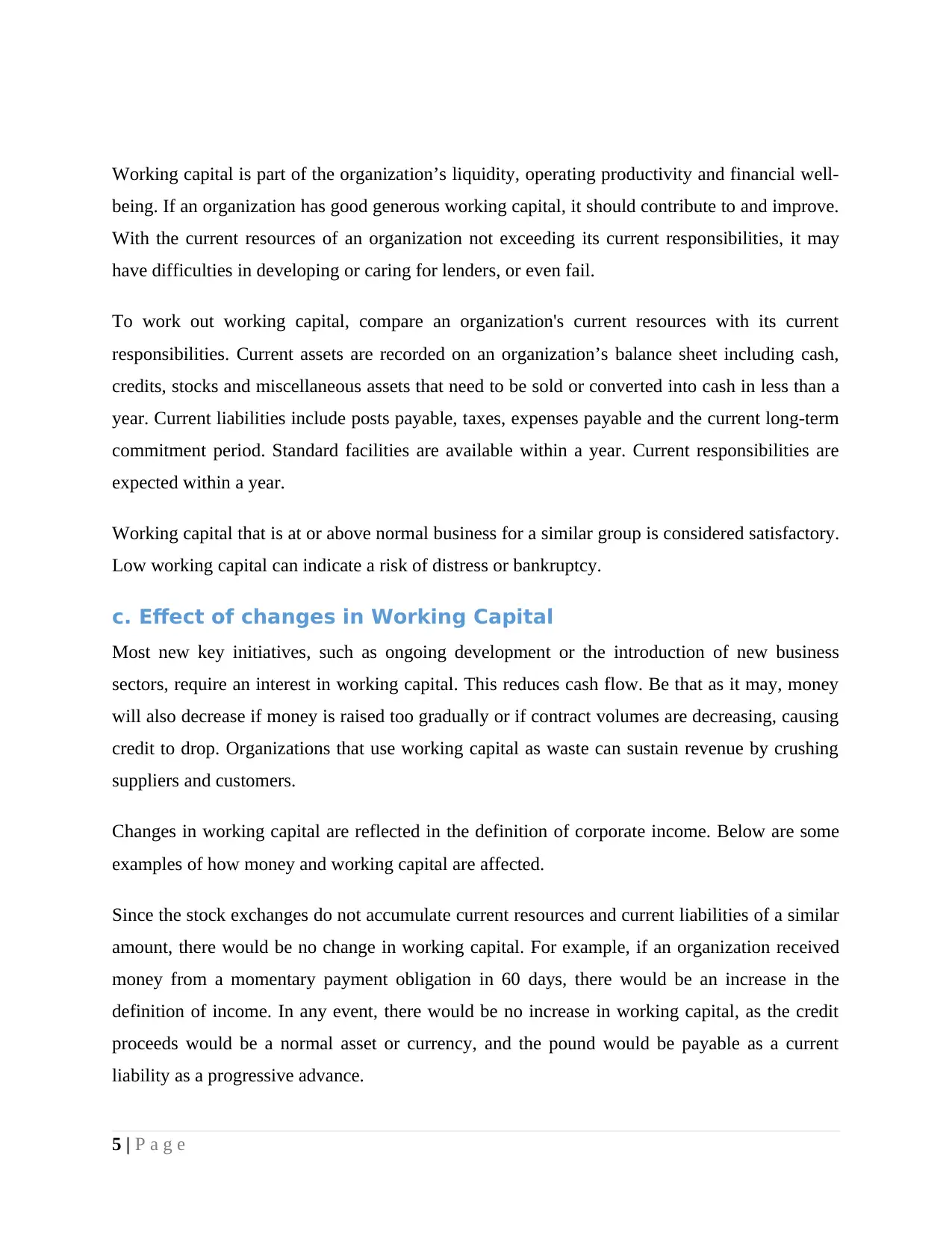
Working capital is part of the organization’s liquidity, operating productivity and financial well-
being. If an organization has good generous working capital, it should contribute to and improve.
With the current resources of an organization not exceeding its current responsibilities, it may
have difficulties in developing or caring for lenders, or even fail.
To work out working capital, compare an organization's current resources with its current
responsibilities. Current assets are recorded on an organization’s balance sheet including cash,
credits, stocks and miscellaneous assets that need to be sold or converted into cash in less than a
year. Current liabilities include posts payable, taxes, expenses payable and the current long-term
commitment period. Standard facilities are available within a year. Current responsibilities are
expected within a year.
Working capital that is at or above normal business for a similar group is considered satisfactory.
Low working capital can indicate a risk of distress or bankruptcy.
c. Effect of changes in Working Capital
Most new key initiatives, such as ongoing development or the introduction of new business
sectors, require an interest in working capital. This reduces cash flow. Be that as it may, money
will also decrease if money is raised too gradually or if contract volumes are decreasing, causing
credit to drop. Organizations that use working capital as waste can sustain revenue by crushing
suppliers and customers.
Changes in working capital are reflected in the definition of corporate income. Below are some
examples of how money and working capital are affected.
Since the stock exchanges do not accumulate current resources and current liabilities of a similar
amount, there would be no change in working capital. For example, if an organization received
money from a momentary payment obligation in 60 days, there would be an increase in the
definition of income. In any event, there would be no increase in working capital, as the credit
proceeds would be a normal asset or currency, and the pound would be payable as a current
liability as a progressive advance.
5 | P a g e
being. If an organization has good generous working capital, it should contribute to and improve.
With the current resources of an organization not exceeding its current responsibilities, it may
have difficulties in developing or caring for lenders, or even fail.
To work out working capital, compare an organization's current resources with its current
responsibilities. Current assets are recorded on an organization’s balance sheet including cash,
credits, stocks and miscellaneous assets that need to be sold or converted into cash in less than a
year. Current liabilities include posts payable, taxes, expenses payable and the current long-term
commitment period. Standard facilities are available within a year. Current responsibilities are
expected within a year.
Working capital that is at or above normal business for a similar group is considered satisfactory.
Low working capital can indicate a risk of distress or bankruptcy.
c. Effect of changes in Working Capital
Most new key initiatives, such as ongoing development or the introduction of new business
sectors, require an interest in working capital. This reduces cash flow. Be that as it may, money
will also decrease if money is raised too gradually or if contract volumes are decreasing, causing
credit to drop. Organizations that use working capital as waste can sustain revenue by crushing
suppliers and customers.
Changes in working capital are reflected in the definition of corporate income. Below are some
examples of how money and working capital are affected.
Since the stock exchanges do not accumulate current resources and current liabilities of a similar
amount, there would be no change in working capital. For example, if an organization received
money from a momentary payment obligation in 60 days, there would be an increase in the
definition of income. In any event, there would be no increase in working capital, as the credit
proceeds would be a normal asset or currency, and the pound would be payable as a current
liability as a progressive advance.
5 | P a g e
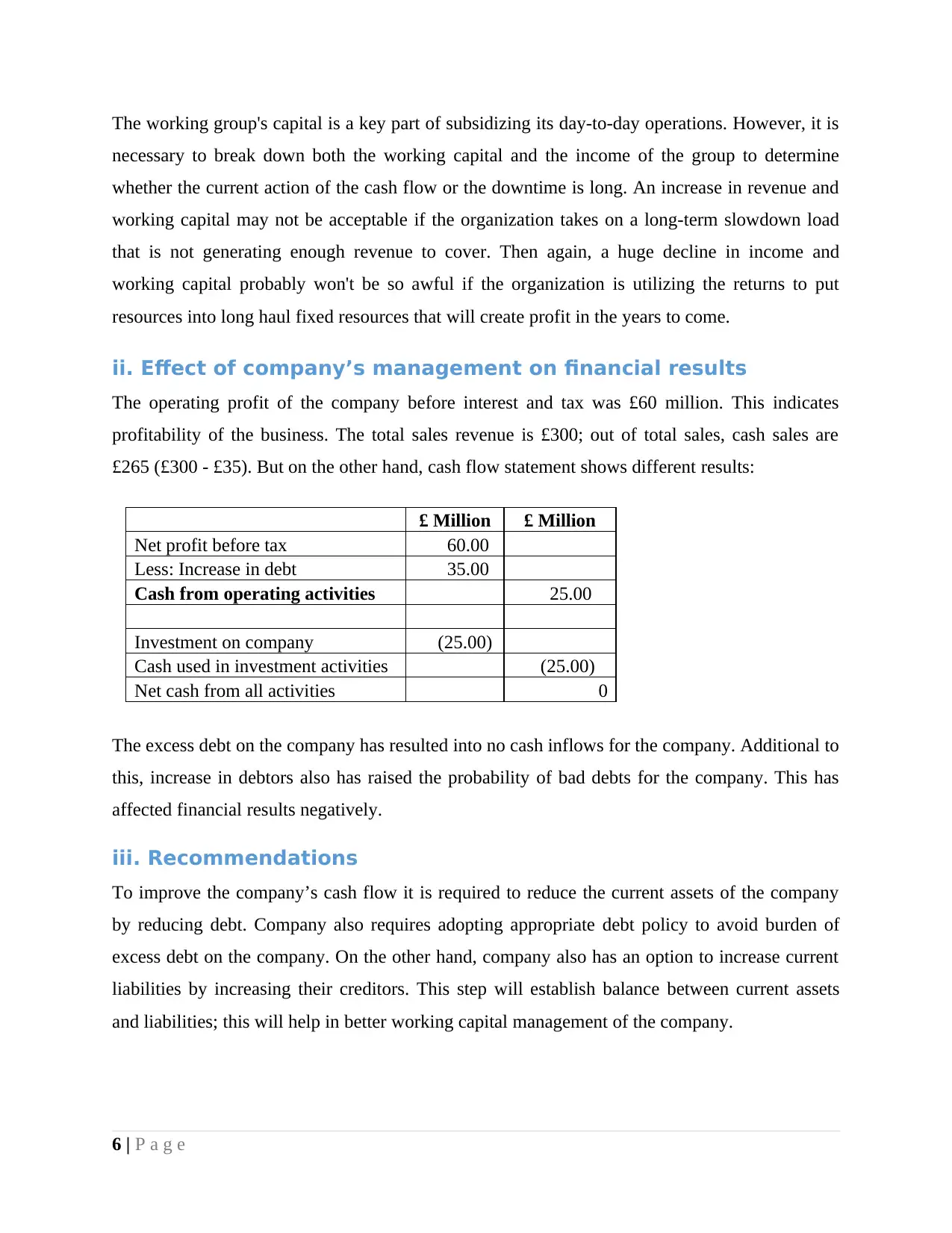
The working group's capital is a key part of subsidizing its day-to-day operations. However, it is
necessary to break down both the working capital and the income of the group to determine
whether the current action of the cash flow or the downtime is long. An increase in revenue and
working capital may not be acceptable if the organization takes on a long-term slowdown load
that is not generating enough revenue to cover. Then again, a huge decline in income and
working capital probably won't be so awful if the organization is utilizing the returns to put
resources into long haul fixed resources that will create profit in the years to come.
ii. Effect of company’s management on financial results
The operating profit of the company before interest and tax was £60 million. This indicates
profitability of the business. The total sales revenue is £300; out of total sales, cash sales are
£265 (£300 - £35). But on the other hand, cash flow statement shows different results:
£ Million £ Million
Net profit before tax 60.00
Less: Increase in debt 35.00
Cash from operating activities 25.00
Investment on company (25.00)
Cash used in investment activities (25.00)
Net cash from all activities 0
The excess debt on the company has resulted into no cash inflows for the company. Additional to
this, increase in debtors also has raised the probability of bad debts for the company. This has
affected financial results negatively.
iii. Recommendations
To improve the company’s cash flow it is required to reduce the current assets of the company
by reducing debt. Company also requires adopting appropriate debt policy to avoid burden of
excess debt on the company. On the other hand, company also has an option to increase current
liabilities by increasing their creditors. This step will establish balance between current assets
and liabilities; this will help in better working capital management of the company.
6 | P a g e
necessary to break down both the working capital and the income of the group to determine
whether the current action of the cash flow or the downtime is long. An increase in revenue and
working capital may not be acceptable if the organization takes on a long-term slowdown load
that is not generating enough revenue to cover. Then again, a huge decline in income and
working capital probably won't be so awful if the organization is utilizing the returns to put
resources into long haul fixed resources that will create profit in the years to come.
ii. Effect of company’s management on financial results
The operating profit of the company before interest and tax was £60 million. This indicates
profitability of the business. The total sales revenue is £300; out of total sales, cash sales are
£265 (£300 - £35). But on the other hand, cash flow statement shows different results:
£ Million £ Million
Net profit before tax 60.00
Less: Increase in debt 35.00
Cash from operating activities 25.00
Investment on company (25.00)
Cash used in investment activities (25.00)
Net cash from all activities 0
The excess debt on the company has resulted into no cash inflows for the company. Additional to
this, increase in debtors also has raised the probability of bad debts for the company. This has
affected financial results negatively.
iii. Recommendations
To improve the company’s cash flow it is required to reduce the current assets of the company
by reducing debt. Company also requires adopting appropriate debt policy to avoid burden of
excess debt on the company. On the other hand, company also has an option to increase current
liabilities by increasing their creditors. This step will establish balance between current assets
and liabilities; this will help in better working capital management of the company.
6 | P a g e
⊘ This is a preview!⊘
Do you want full access?
Subscribe today to unlock all pages.

Trusted by 1+ million students worldwide
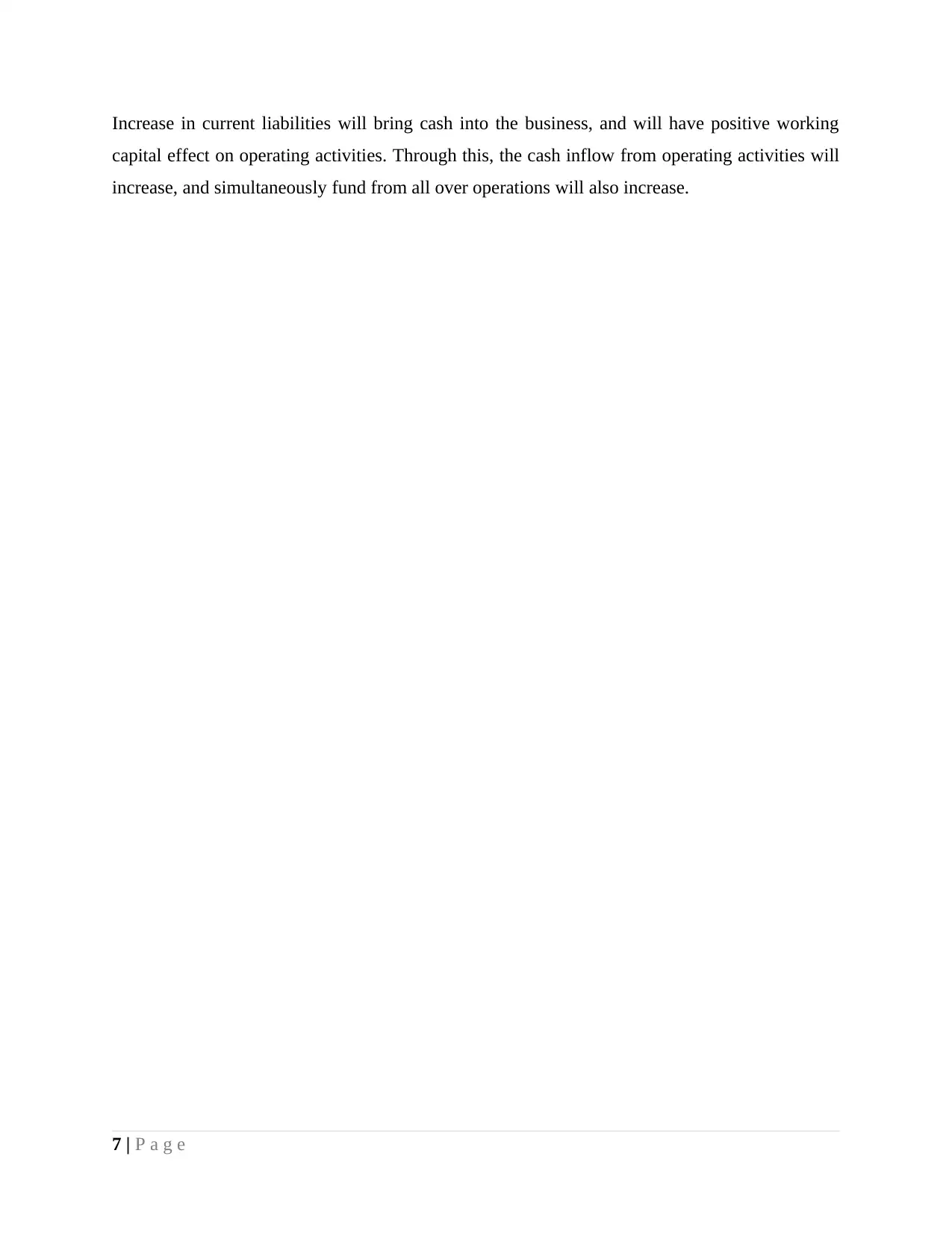
Increase in current liabilities will bring cash into the business, and will have positive working
capital effect on operating activities. Through this, the cash inflow from operating activities will
increase, and simultaneously fund from all over operations will also increase.
7 | P a g e
capital effect on operating activities. Through this, the cash inflow from operating activities will
increase, and simultaneously fund from all over operations will also increase.
7 | P a g e
Paraphrase This Document
Need a fresh take? Get an instant paraphrase of this document with our AI Paraphraser
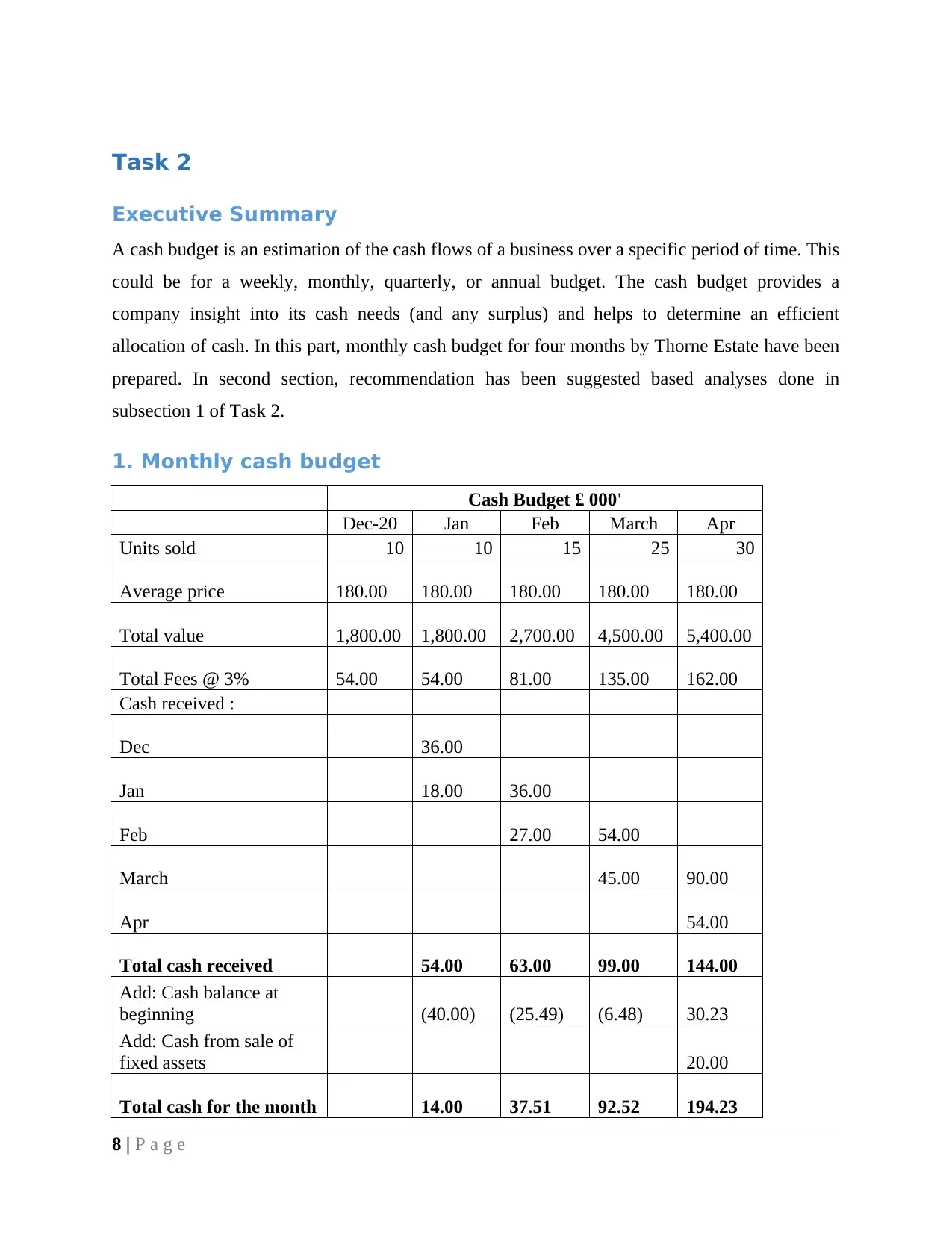
Task 2
Executive Summary
A cash budget is an estimation of the cash flows of a business over a specific period of time. This
could be for a weekly, monthly, quarterly, or annual budget. The cash budget provides a
company insight into its cash needs (and any surplus) and helps to determine an efficient
allocation of cash. In this part, monthly cash budget for four months by Thorne Estate have been
prepared. In second section, recommendation has been suggested based analyses done in
subsection 1 of Task 2.
1. Monthly cash budget
Cash Budget £ 000'
Dec-20 Jan Feb March Apr
Units sold 10 10 15 25 30
Average price 180.00 180.00 180.00 180.00 180.00
Total value 1,800.00 1,800.00 2,700.00 4,500.00 5,400.00
Total Fees @ 3% 54.00 54.00 81.00 135.00 162.00
Cash received :
Dec 36.00
Jan 18.00 36.00
Feb 27.00 54.00
March 45.00 90.00
Apr 54.00
Total cash received 54.00 63.00 99.00 144.00
Add: Cash balance at
beginning (40.00) (25.49) (6.48) 30.23
Add: Cash from sale of
fixed assets 20.00
Total cash for the month 14.00 37.51 92.52 194.23
8 | P a g e
Executive Summary
A cash budget is an estimation of the cash flows of a business over a specific period of time. This
could be for a weekly, monthly, quarterly, or annual budget. The cash budget provides a
company insight into its cash needs (and any surplus) and helps to determine an efficient
allocation of cash. In this part, monthly cash budget for four months by Thorne Estate have been
prepared. In second section, recommendation has been suggested based analyses done in
subsection 1 of Task 2.
1. Monthly cash budget
Cash Budget £ 000'
Dec-20 Jan Feb March Apr
Units sold 10 10 15 25 30
Average price 180.00 180.00 180.00 180.00 180.00
Total value 1,800.00 1,800.00 2,700.00 4,500.00 5,400.00
Total Fees @ 3% 54.00 54.00 81.00 135.00 162.00
Cash received :
Dec 36.00
Jan 18.00 36.00
Feb 27.00 54.00
March 45.00 90.00
Apr 54.00
Total cash received 54.00 63.00 99.00 144.00
Add: Cash balance at
beginning (40.00) (25.49) (6.48) 30.23
Add: Cash from sale of
fixed assets 20.00
Total cash for the month 14.00 37.51 92.52 194.23
8 | P a g e
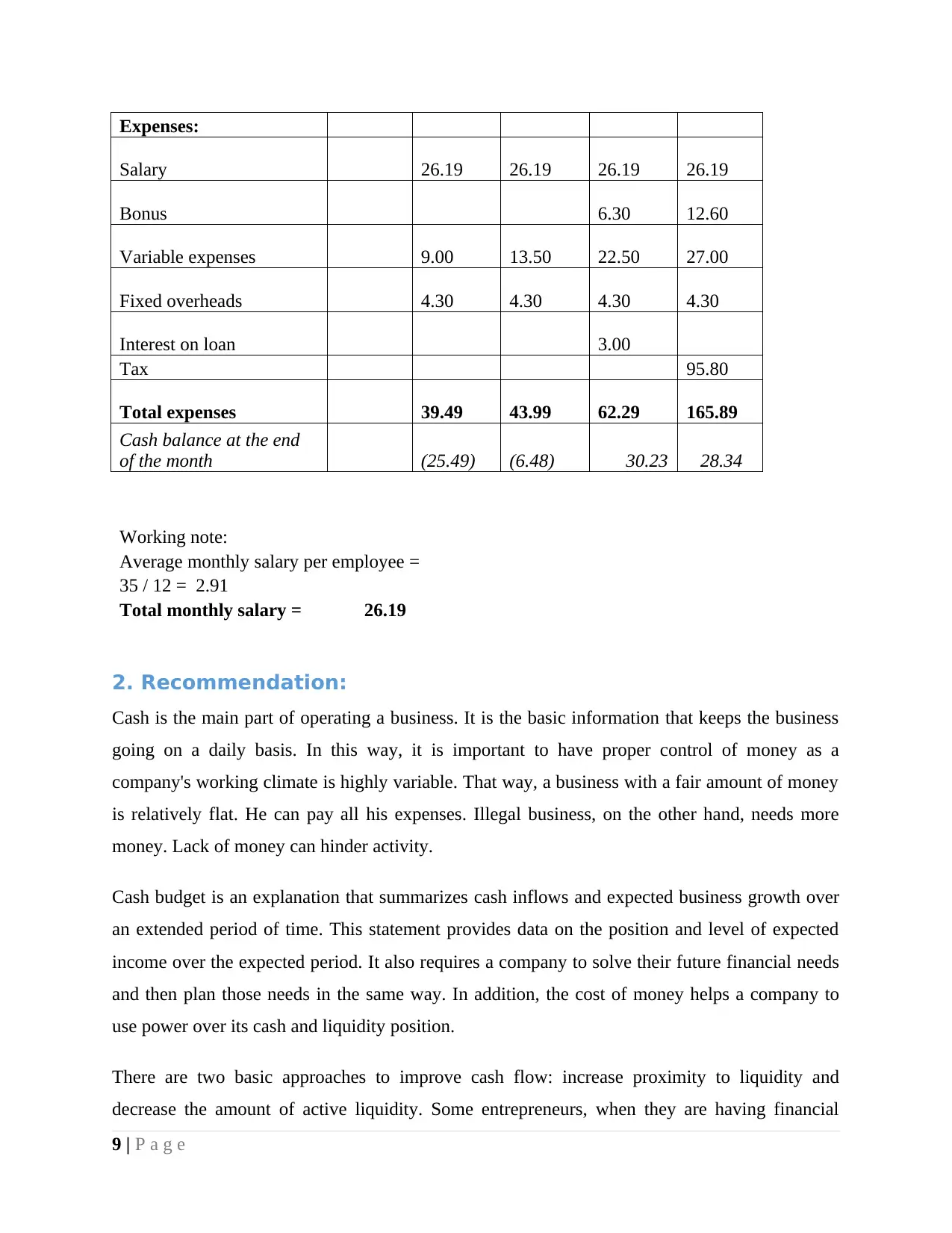
Expenses:
Salary 26.19 26.19 26.19 26.19
Bonus 6.30 12.60
Variable expenses 9.00 13.50 22.50 27.00
Fixed overheads 4.30 4.30 4.30 4.30
Interest on loan 3.00
Tax 95.80
Total expenses 39.49 43.99 62.29 165.89
Cash balance at the end
of the month (25.49) (6.48) 30.23 28.34
Working note:
Average monthly salary per employee =
35 / 12 = 2.91
Total monthly salary = 26.19
2. Recommendation:
Cash is the main part of operating a business. It is the basic information that keeps the business
going on a daily basis. In this way, it is important to have proper control of money as a
company's working climate is highly variable. That way, a business with a fair amount of money
is relatively flat. He can pay all his expenses. Illegal business, on the other hand, needs more
money. Lack of money can hinder activity.
Cash budget is an explanation that summarizes cash inflows and expected business growth over
an extended period of time. This statement provides data on the position and level of expected
income over the expected period. It also requires a company to solve their future financial needs
and then plan those needs in the same way. In addition, the cost of money helps a company to
use power over its cash and liquidity position.
There are two basic approaches to improve cash flow: increase proximity to liquidity and
decrease the amount of active liquidity. Some entrepreneurs, when they are having financial
9 | P a g e
Salary 26.19 26.19 26.19 26.19
Bonus 6.30 12.60
Variable expenses 9.00 13.50 22.50 27.00
Fixed overheads 4.30 4.30 4.30 4.30
Interest on loan 3.00
Tax 95.80
Total expenses 39.49 43.99 62.29 165.89
Cash balance at the end
of the month (25.49) (6.48) 30.23 28.34
Working note:
Average monthly salary per employee =
35 / 12 = 2.91
Total monthly salary = 26.19
2. Recommendation:
Cash is the main part of operating a business. It is the basic information that keeps the business
going on a daily basis. In this way, it is important to have proper control of money as a
company's working climate is highly variable. That way, a business with a fair amount of money
is relatively flat. He can pay all his expenses. Illegal business, on the other hand, needs more
money. Lack of money can hinder activity.
Cash budget is an explanation that summarizes cash inflows and expected business growth over
an extended period of time. This statement provides data on the position and level of expected
income over the expected period. It also requires a company to solve their future financial needs
and then plan those needs in the same way. In addition, the cost of money helps a company to
use power over its cash and liquidity position.
There are two basic approaches to improve cash flow: increase proximity to liquidity and
decrease the amount of active liquidity. Some entrepreneurs, when they are having financial
9 | P a g e
⊘ This is a preview!⊘
Do you want full access?
Subscribe today to unlock all pages.

Trusted by 1+ million students worldwide
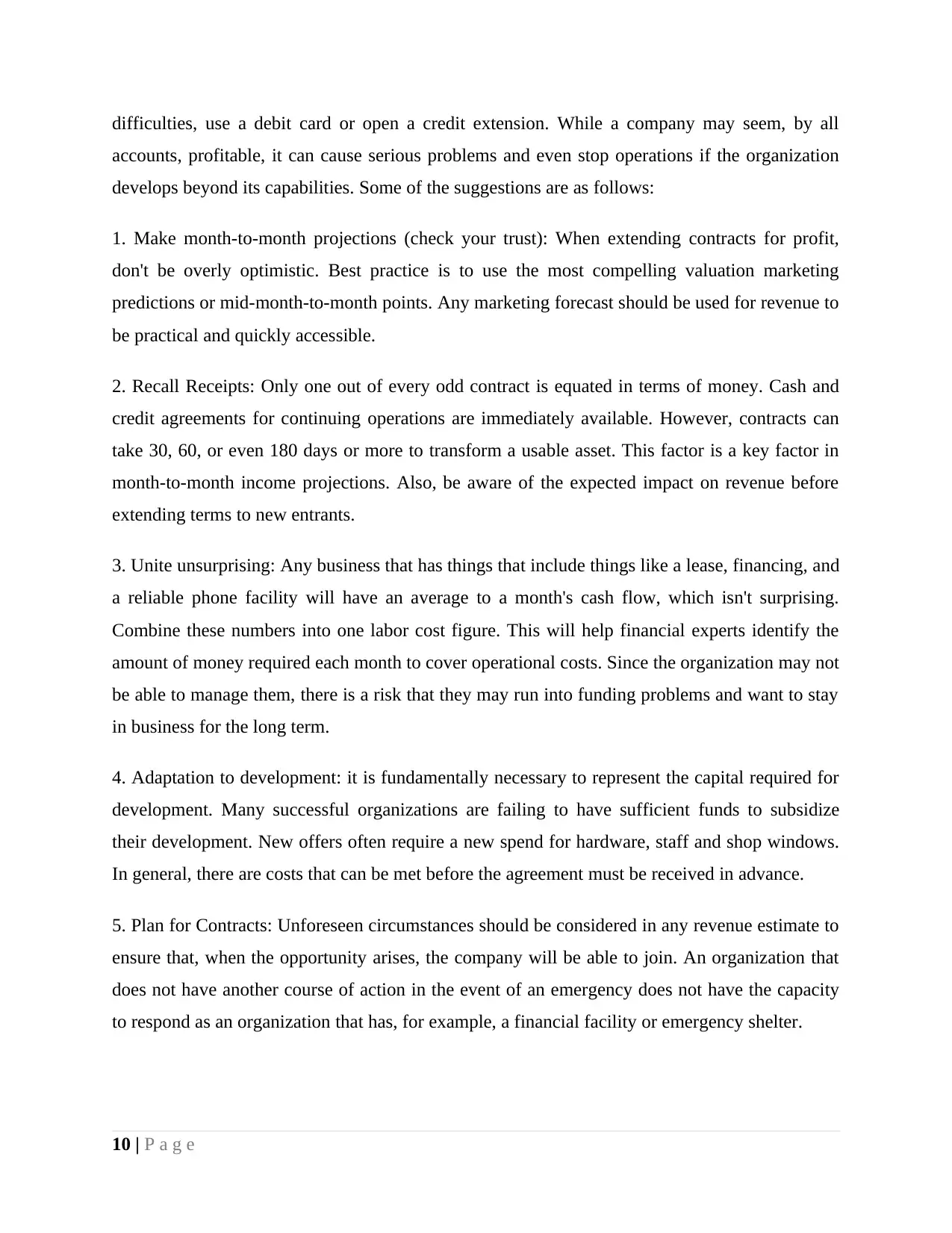
difficulties, use a debit card or open a credit extension. While a company may seem, by all
accounts, profitable, it can cause serious problems and even stop operations if the organization
develops beyond its capabilities. Some of the suggestions are as follows:
1. Make month-to-month projections (check your trust): When extending contracts for profit,
don't be overly optimistic. Best practice is to use the most compelling valuation marketing
predictions or mid-month-to-month points. Any marketing forecast should be used for revenue to
be practical and quickly accessible.
2. Recall Receipts: Only one out of every odd contract is equated in terms of money. Cash and
credit agreements for continuing operations are immediately available. However, contracts can
take 30, 60, or even 180 days or more to transform a usable asset. This factor is a key factor in
month-to-month income projections. Also, be aware of the expected impact on revenue before
extending terms to new entrants.
3. Unite unsurprising: Any business that has things that include things like a lease, financing, and
a reliable phone facility will have an average to a month's cash flow, which isn't surprising.
Combine these numbers into one labor cost figure. This will help financial experts identify the
amount of money required each month to cover operational costs. Since the organization may not
be able to manage them, there is a risk that they may run into funding problems and want to stay
in business for the long term.
4. Adaptation to development: it is fundamentally necessary to represent the capital required for
development. Many successful organizations are failing to have sufficient funds to subsidize
their development. New offers often require a new spend for hardware, staff and shop windows.
In general, there are costs that can be met before the agreement must be received in advance.
5. Plan for Contracts: Unforeseen circumstances should be considered in any revenue estimate to
ensure that, when the opportunity arises, the company will be able to join. An organization that
does not have another course of action in the event of an emergency does not have the capacity
to respond as an organization that has, for example, a financial facility or emergency shelter.
10 | P a g e
accounts, profitable, it can cause serious problems and even stop operations if the organization
develops beyond its capabilities. Some of the suggestions are as follows:
1. Make month-to-month projections (check your trust): When extending contracts for profit,
don't be overly optimistic. Best practice is to use the most compelling valuation marketing
predictions or mid-month-to-month points. Any marketing forecast should be used for revenue to
be practical and quickly accessible.
2. Recall Receipts: Only one out of every odd contract is equated in terms of money. Cash and
credit agreements for continuing operations are immediately available. However, contracts can
take 30, 60, or even 180 days or more to transform a usable asset. This factor is a key factor in
month-to-month income projections. Also, be aware of the expected impact on revenue before
extending terms to new entrants.
3. Unite unsurprising: Any business that has things that include things like a lease, financing, and
a reliable phone facility will have an average to a month's cash flow, which isn't surprising.
Combine these numbers into one labor cost figure. This will help financial experts identify the
amount of money required each month to cover operational costs. Since the organization may not
be able to manage them, there is a risk that they may run into funding problems and want to stay
in business for the long term.
4. Adaptation to development: it is fundamentally necessary to represent the capital required for
development. Many successful organizations are failing to have sufficient funds to subsidize
their development. New offers often require a new spend for hardware, staff and shop windows.
In general, there are costs that can be met before the agreement must be received in advance.
5. Plan for Contracts: Unforeseen circumstances should be considered in any revenue estimate to
ensure that, when the opportunity arises, the company will be able to join. An organization that
does not have another course of action in the event of an emergency does not have the capacity
to respond as an organization that has, for example, a financial facility or emergency shelter.
10 | P a g e
Paraphrase This Document
Need a fresh take? Get an instant paraphrase of this document with our AI Paraphraser
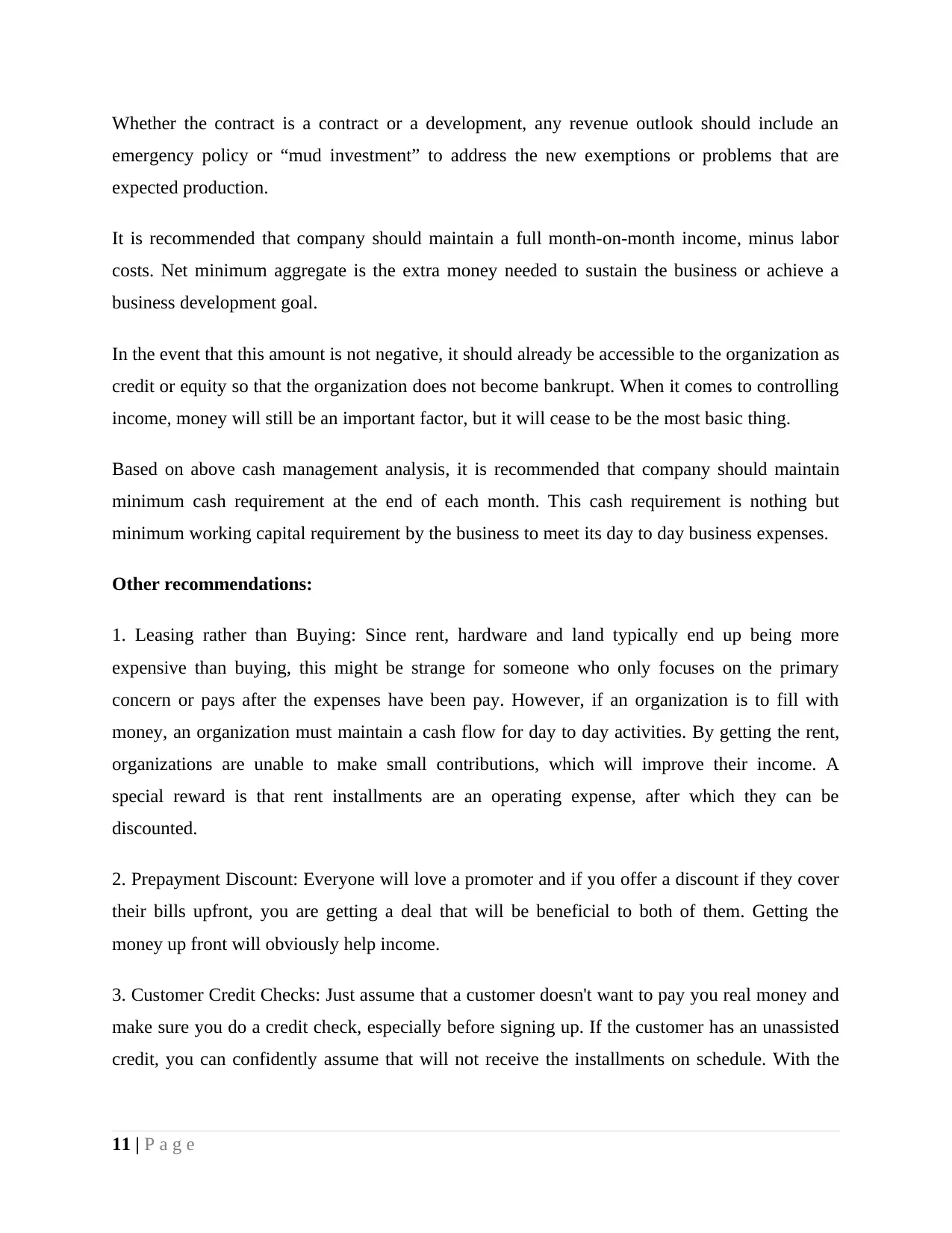
Whether the contract is a contract or a development, any revenue outlook should include an
emergency policy or “mud investment” to address the new exemptions or problems that are
expected production.
It is recommended that company should maintain a full month-on-month income, minus labor
costs. Net minimum aggregate is the extra money needed to sustain the business or achieve a
business development goal.
In the event that this amount is not negative, it should already be accessible to the organization as
credit or equity so that the organization does not become bankrupt. When it comes to controlling
income, money will still be an important factor, but it will cease to be the most basic thing.
Based on above cash management analysis, it is recommended that company should maintain
minimum cash requirement at the end of each month. This cash requirement is nothing but
minimum working capital requirement by the business to meet its day to day business expenses.
Other recommendations:
1. Leasing rather than Buying: Since rent, hardware and land typically end up being more
expensive than buying, this might be strange for someone who only focuses on the primary
concern or pays after the expenses have been pay. However, if an organization is to fill with
money, an organization must maintain a cash flow for day to day activities. By getting the rent,
organizations are unable to make small contributions, which will improve their income. A
special reward is that rent installments are an operating expense, after which they can be
discounted.
2. Prepayment Discount: Everyone will love a promoter and if you offer a discount if they cover
their bills upfront, you are getting a deal that will be beneficial to both of them. Getting the
money up front will obviously help income.
3. Customer Credit Checks: Just assume that a customer doesn't want to pay you real money and
make sure you do a credit check, especially before signing up. If the customer has an unassisted
credit, you can confidently assume that will not receive the installments on schedule. With the
11 | P a g e
emergency policy or “mud investment” to address the new exemptions or problems that are
expected production.
It is recommended that company should maintain a full month-on-month income, minus labor
costs. Net minimum aggregate is the extra money needed to sustain the business or achieve a
business development goal.
In the event that this amount is not negative, it should already be accessible to the organization as
credit or equity so that the organization does not become bankrupt. When it comes to controlling
income, money will still be an important factor, but it will cease to be the most basic thing.
Based on above cash management analysis, it is recommended that company should maintain
minimum cash requirement at the end of each month. This cash requirement is nothing but
minimum working capital requirement by the business to meet its day to day business expenses.
Other recommendations:
1. Leasing rather than Buying: Since rent, hardware and land typically end up being more
expensive than buying, this might be strange for someone who only focuses on the primary
concern or pays after the expenses have been pay. However, if an organization is to fill with
money, an organization must maintain a cash flow for day to day activities. By getting the rent,
organizations are unable to make small contributions, which will improve their income. A
special reward is that rent installments are an operating expense, after which they can be
discounted.
2. Prepayment Discount: Everyone will love a promoter and if you offer a discount if they cover
their bills upfront, you are getting a deal that will be beneficial to both of them. Getting the
money up front will obviously help income.
3. Customer Credit Checks: Just assume that a customer doesn't want to pay you real money and
make sure you do a credit check, especially before signing up. If the customer has an unassisted
credit, you can confidently assume that will not receive the installments on schedule. With the
11 | P a g e
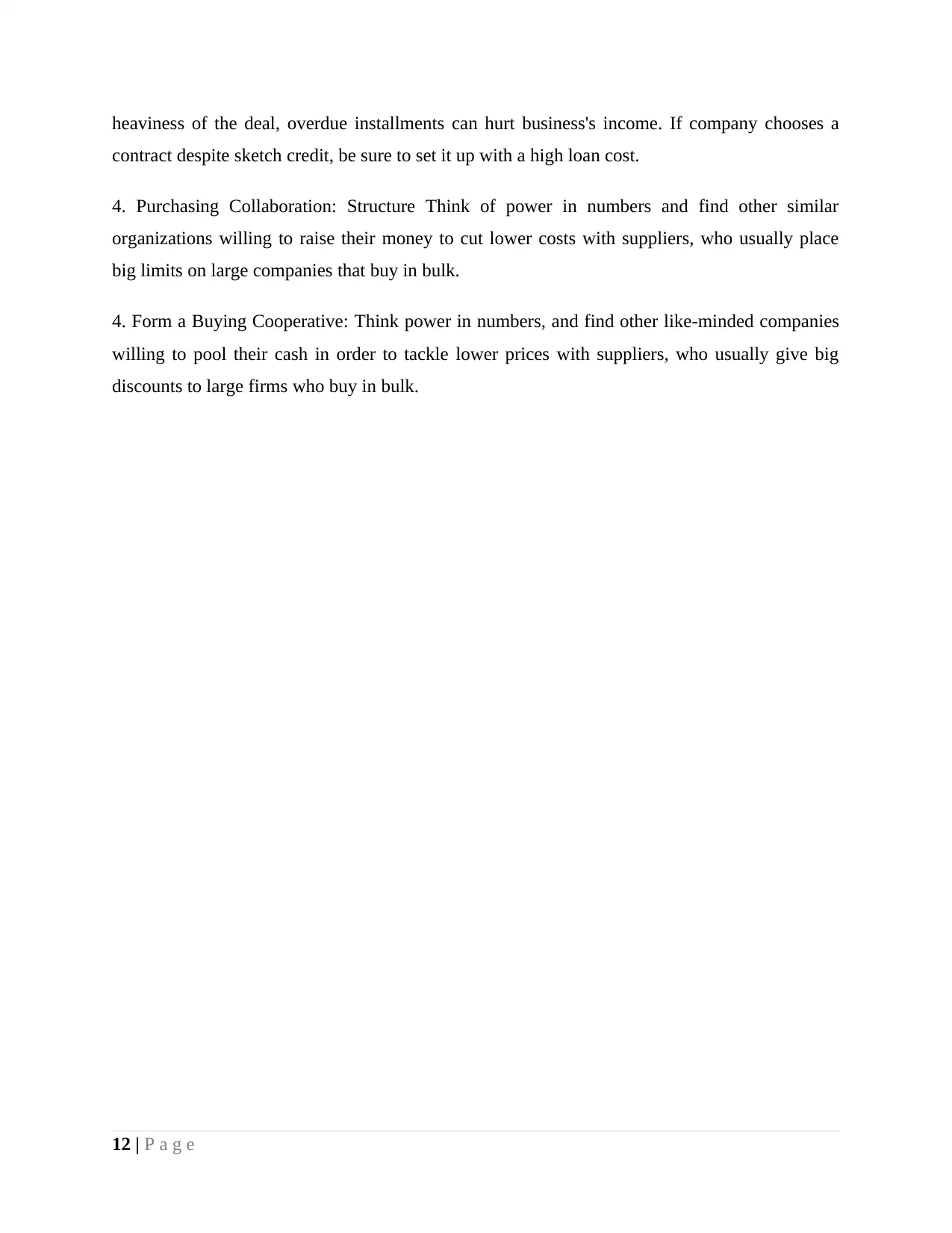
heaviness of the deal, overdue installments can hurt business's income. If company chooses a
contract despite sketch credit, be sure to set it up with a high loan cost.
4. Purchasing Collaboration: Structure Think of power in numbers and find other similar
organizations willing to raise their money to cut lower costs with suppliers, who usually place
big limits on large companies that buy in bulk.
4. Form a Buying Cooperative: Think power in numbers, and find other like-minded companies
willing to pool their cash in order to tackle lower prices with suppliers, who usually give big
discounts to large firms who buy in bulk.
12 | P a g e
contract despite sketch credit, be sure to set it up with a high loan cost.
4. Purchasing Collaboration: Structure Think of power in numbers and find other similar
organizations willing to raise their money to cut lower costs with suppliers, who usually place
big limits on large companies that buy in bulk.
4. Form a Buying Cooperative: Think power in numbers, and find other like-minded companies
willing to pool their cash in order to tackle lower prices with suppliers, who usually give big
discounts to large firms who buy in bulk.
12 | P a g e
⊘ This is a preview!⊘
Do you want full access?
Subscribe today to unlock all pages.

Trusted by 1+ million students worldwide
1 out of 13
Related Documents
Your All-in-One AI-Powered Toolkit for Academic Success.
+13062052269
info@desklib.com
Available 24*7 on WhatsApp / Email
![[object Object]](/_next/static/media/star-bottom.7253800d.svg)
Unlock your academic potential
Copyright © 2020–2025 A2Z Services. All Rights Reserved. Developed and managed by ZUCOL.





